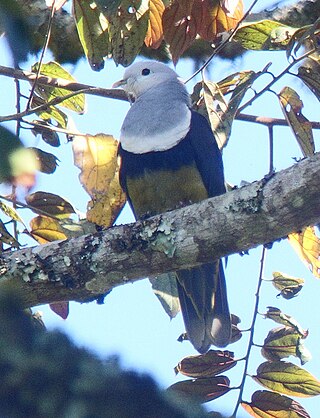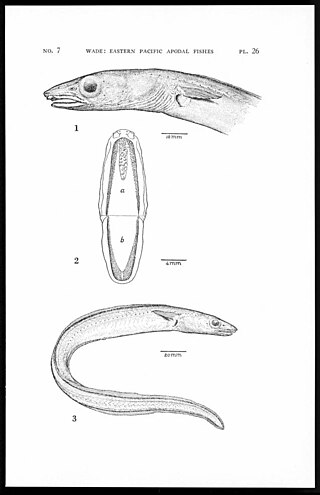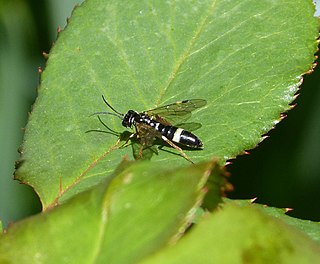
The grey-headed chickadee or Siberian tit, formerly Parus cinctus, is a passerine bird in the tit family Paridae. It is a widespread resident breeder throughout subarctic Scandinavia and the northern Palearctic, and also into North America in Alaska and the far northwest of Canada. It is a conifer specialist. It is resident, and most birds do not migrate. Curiously, the bird has no grey on its head, which is black, white, and brown.

The girdled wrasse, Notolabrus cinctus, is a species of wrasse native to the waters around the South Island and southeastern North Island of New Zealand, including the Chatham Islands and Snares Islands, where it can be found at depths from 15 to 91 m. The males of this species can reach 29.9 cm (11.8 in) in standard length, while the females only reach 29.1 cm (11.5 in). There are two colour phases with older fish developing a large, dusky belt around the body. This is not associated with changing sex which happens about three years after the development of the belt. They feed on molluscs and small crustacea. They occur on rocky reefs, where they are common.

The yellowbanded perch, also known as the yellowbanded wirrah and girdled rock cod, is a species of ray-finned fish in the family Serranidae, the groupers and sea basses. It is native to the southern Pacific Ocean, where it occurs along the coasts of eastern Australia and New Zealand.

The banded fruit dove or black-backed fruit dove is a large pigeon with white head, neck and upper breast; black back and upperwing grading to grey on rump; black tail with broad grey terminal band; underparts grey, demarcated from white head.

The red-kneed dotterel is a species of plover in a monotypic genus in the subfamily Vanellinae. It is often gregarious and will associate with other waders of its own and different species, even when nesting. It is nomadic and sometimes irruptive.

The tawny-faced quail is a species of bird in the family Odontophoridae, the New World quail. It is found in Colombia, Costa Rica, Ecuador, Honduras, Nicaragua, and Panama.

The three-banded courser is a species of bird in the family Glareolidae. It is found in Angola, Botswana, Ethiopia, Kenya, Namibia, Rwanda, Somalia, Somaliland, South Africa, South Sudan, Tanzania, Uganda, Zambia, and Zimbabwe.

The yellow prawn-goby is a species of goby native to the Western Pacific, where it can be found at depths of from 1 to 25 metres in coastal bays and lagoons. This species is symbiotic with alpheid shrimps. The species can reach a length of 10 centimetres (3.9 in) SL. These fish vary greatly in appearance, ranging from brilliant yellow to gray and even brown forms or combinations of each coloring. This species is often kept in salt water aquariums. The yellow prawn-goby can be kept in aquariums as small as 20 gallons. In the marine hobby they are often partnered with tiger pistol shrimp.
Heteristius cinctus, the banded stargazer, is a species of sand stargazer native to the Pacific coast of the Americas from Baja California, Mexico to Ecuador where it can be found on sandy bottoms at depths of from 1 to 27 m. It can reach a maximum of 4.5 cm (1.8 in) in total length. This species is currently the only known member of its genus.

Gnathophis cinctus, the hardtail conger or Catalina conger, is an eel in the family Congridae. It was described by Samuel Garman in 1899, originally under the genus Atopichthys. It is a tropical, marine eel which is known from the eastern central and southeastern Pacific Ocean, including Chile, Colombia, Costa Rica, Ecuador, El Salvador, Guatemala, Honduras, Mexico, Nicaragua, Panama, Peru, and the United States. It dwells at a depth range of 9–336 metres, and leads a benthic lifestyle, burrowing into loose sand. Males can reach a maximum total length of 42 cm.

Allantus cinctus, known generally as the curled rose sawfly or banded rose sawfly, is a species of common sawfly in the family Tenthredinidae. It is found in Europe.

Cyrtolobus is a genus of treehoppers in the family Membracidae. There are more than 50 described species in Cyrtolobus, found in North and Central America.

Cyrtolobus vau is a species of treehopper belonging to the genus Cyrtolobus. It was first described by Thomas Say in 1830.

Cyrtolobus tuberosus is a species of treehopper belonging to the genus Cyrtolobus. It was first described by Léon Fairmaire in 1846 as Thelia tuberosa. It is the largest treehopper in the Cyrtolobus genus, 9-10mm for females and 7-8mm for males
Cyrtolobus acutus is a species of treehopper. It was first described by Edward P. Van Duzee in 1908. It is found in the south-western United States.
Cyrtolobus maxinei is a species of treehopper belonging to the genus Cyrtolobus. It was first described by R. W. G. Dennis in 1970.
Cyrtolobus clarus is a species of treehopper belonging to the genus Cyrtolobus and the family Membracidae.

Cyrtolobus maculifrontis is a species of treehopper belonging to the genus Cyrtolobus and the family Membracidae. It was first described by Ebenezer Emmons in 1854.
Cyrtolobus arizonae is a species of treehopper belonging to the genus Cyrtolobus in the family Membracidae. It was first described by Elmer Darwin Ball in 1932.
Cyrtolobus arcuatus is a species of treehopper belonging to the family Membracidae. It is found in eastern and southern United States.













